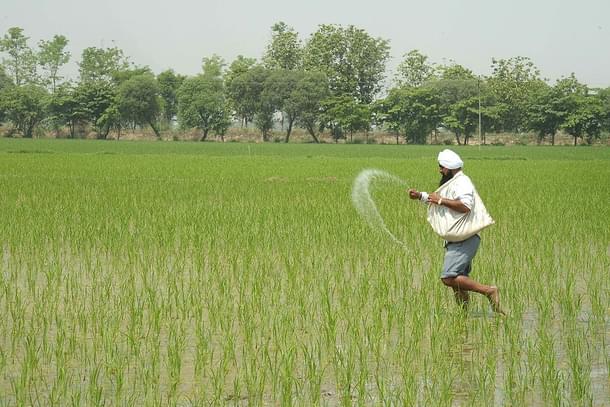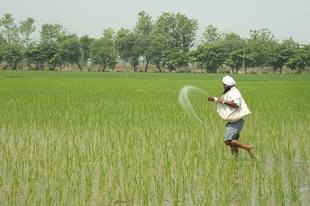Magazine
Capital, Capital And Capital - What Indian Agricultural Insurance Sector Needs
C Shivkumar
Jun 03, 2018, 05:04 PM | Updated 05:04 PM IST
Save & read from anywhere!
Bookmark stories for easy access on any device or the Swarajya app.


The crop insurance scheme of the government has come under intense scrutiny and criticism by opposition politicians and the media. Among the key criticisms levelled was that the insurance companies were indulging in profiteering using crop insurance as a vehicle. Crop insurance is a risk cover scheme against losses to farm output and income. What is true is that crop insurance is indeed a profitable scheme as far as insurers are concerned. Crop insurance has lower claims ratios than say motor or health. In the case of the latter, the claims are over 100 per cent of the premiums collected, leading to capital bleeding for the insurers. Claims ratios for crop insurance schemes are just about 80 per cent for the insurance companies. Low claims ratios imply that at least 20 per cent of the premiums are retained by the insurance companies translating into profits.
Yet, most of the criticism appears hardly justified. Insurers meet claim payouts only after loss events are reported and after verification of the claim applications. So it only means that the claims lodged with the insurers were low, or loss events — particularly natural calamities covered by the policies, had not occurred in the regions. However, what was also true was that most claim applications lodged with the public and private sector insurance companies were cleared during both the kharif and rabi seasons. In fact, this was one of the major reasons for an average claims ratio of 80 per cent across both public and private sector insurance companies. It clearly meant payouts had been made.
Prime Minister’s Fasal Bima Yojana is a slight improvement of the National Agricultural Insurance Scheme that was started way back in the 1990s. The Fasal Bima Yojana is not very different from the original scheme. It has undergone a series of tweaks. The present Fasal Bima Yojana is just another improvement over the originally conceived crop insurance scheme pioneered by the Life Insurance Corporation in 1972, though subsequently taken over the General Insurance Corporation (GIC), after nationalisation.
All farmers, including share croppers and tenant farmers are eligible for coverage under the scheme. Crop insurance though is mandatory for farmers who have availed of loan support from the banking system. This was to ensure that in the event of a crop failure, the farmers were free from any debt encumbrances to banks or financial institutions. However, for non-loanee farmers, insurance cover is only voluntary. But the crop insurance scheme allows them to mitigate financial losses due to weather vagaries. Indian agriculture is perennially prone to volatile weather conditions. Crops covered include cereals, coarse grains, oilseeds and horticulture crops.
In terms of coverage, there is little doubt that crop insurance has been a success in mitigating farmer distress. According to official figures, until 2016, at least 37 million farmers in the country were covered under the Pradhan Mantri Fasal Bima Yojana. The gross sum assured was Rs 1.5 lakh crore on a farmer premium of Rs 2,939 crore. The total farm area covered in the country under the scheme was 38 million hectares. The data indicated claims settlement amounted close to Rs 6,000 crore for both kharif (July to October) and rabi (October-March) seasons in 2016.
The premiums for all the schemes are shared trilaterally. The farmer premium cost is a maximum of about 2 per cent of the sum insured, depending on the season, kharif or rabi, for cereal and oilseed crops, and five per cent for horticulture crops. The subsidy on the premiums based on the difference between the actuarial rates and the rates levied on the farmers is shared by the Centre and the state government. Claims though would have to be settled by the insurers themselves.
Yet, the crop insurance scheme is not without flaws. A major flaw is the dependence on state governments. Notifications of calamities are determined by the state governments. Essentially, what appears to have occurred was that state governments were slow to respond to calamities like droughts and floods. The delays leave farmers in a liquidity crisis during the period when the claims have to be lodged. Particularly vulnerable are non-loanee or tenant farmers, who are mostly dependent on informal sources of credit during the period, leading to financial distress.
The other major flaw is that claim settlements are made on the basis of an “area approach”. This essentially means that the defined area for calamity level claims event is usually a tehsil or panchayat or a revenue circle or at the discretion of the state governments. It is in these particularly demarcated and notified areas that the crop cutting experiments are conducted for verification of insurance claim events to farmers. The yield estimates in these demarcated regions are submitted to the insurance companies for claims settlements by farmers. As a result, claims settlements are usually delayed.
The area approach is expected to be tweaked to further mitigate farmer distress. This includes use of satellite imagery for ascertaining claim events. The expectation is that usage of satellite imagery would minimise the need for crop cutting experiments and provide for expediting the claim settlements.
Yet, despite the improvement in the insurance coverage, there are still deficits. Although statistically impressive, the actual farm risk underwritten was barely 20 per cent of the area under cultivation in the country. In 2016, for instance, the area under foodgrains cultivation alone was about 125 million hectares. Crop insurance therefore, even with private sector support, covered less than a third of the foodgrain area. That still leaves a long way to go, although the crop insurance programme started in 1972.
However, expanding underwriting of farm risks or crop insurance, also means that insurers need to be better capitalised. This is in view of the present tight solvency norms of 150 per cent. Solvency implies the excess of capital and value assets over the insured liabilities. That means that for every Rs 100 covered, insurance would need to have capital and assets worth Rs 150. The regulation in turn implies that greater coverage of farm area would mean increased capital requirements for solvency requirements. So far the government has not been forthcoming on capitalisation of the insurance companies in the public sector.
Instead, what has been offered is a subsidy on premiums, meaning the costs are largely borne by the governments — Centre and states. This year (2018-19), for instance, the Centre’s budgetary allocation for crop insurance, essentially its share in premium subsidies, is Rs 13,000 crore or an increase of Rs 3,000 crore over 2017-18. This means that the states would have to bring in at least another Rs 13000 crore as their shares. But states are more obsessed with being fiscally correct instead of meeting needs of economic welfare and food security. Take the instance of Kerala, where the budgetary allocation for crop insurance was actually halved to Rs 6 crore for fiscal year 2018-19. Last year it was Rs 12.5 crore.
Although crop insurance subsidies have a sunset clause built into them, there is little scope for deregulation of the crop insurance market in the immediate future. Deregulation of the crop insurance market would however most likely translate into a substantial increase in premia. Farm incomes are still low. Any deregulation could therefore lead to cost stresses and to a passthrough effect and in turn have an effect on the minimum support prices that are periodically announced by the Centre and state. Moreover, private sector insurers are unlikely to become major players without a deregulation in the pricing.
Faced with compelling government directives, insurers have been expanding their coverage. At the same time, insurers are resorting to reinsurance so as to comply with the regulatory solvency norms. Reinsurance essentially implies ceding a portion of the policy to the national reinsurer, GIC or the Agriculture Insurance Company of India or to specialist international insurers. The ceding or selling allows primary insurers to earn a commission that becomes an income on their balance sheets. At the same time, it also reduces the liability on the primary insurer. Among the foreign insurers that have taken interest in India’s crop insurance market are entities like Zurich-based Swiss Re, Korea Re and Toa Re of Japan.
Yet, as insurers admit, even reinsurers have limits. The global reinsurance markets are presently soft, but could suddenly turn volatile. Insurers admit that there is very little option other than additional capitalisation of the insurance companies for increasing coverage area to at least 50 per cent of what is presently sown. “Jai Kisan” is a nice slogan, but still needs humungous capital!
The author is a financial journalist with over 30 years of experience, having worked with various publications and as a foreign currency trader. He is now settled in the mountain town of Kotagiri, in the Nilgiris district ofTamil Nadu, where he pursues his twin passions of wildlife photography and farming.





